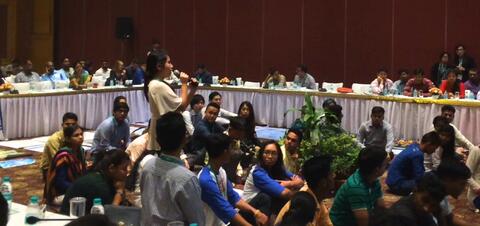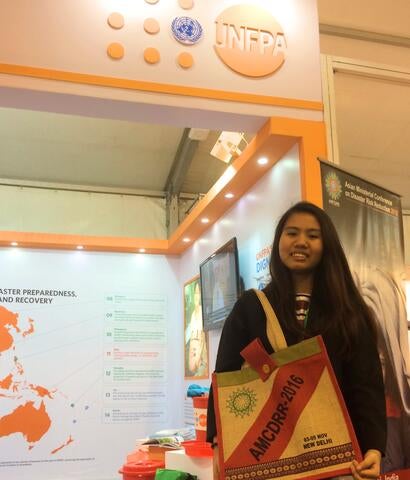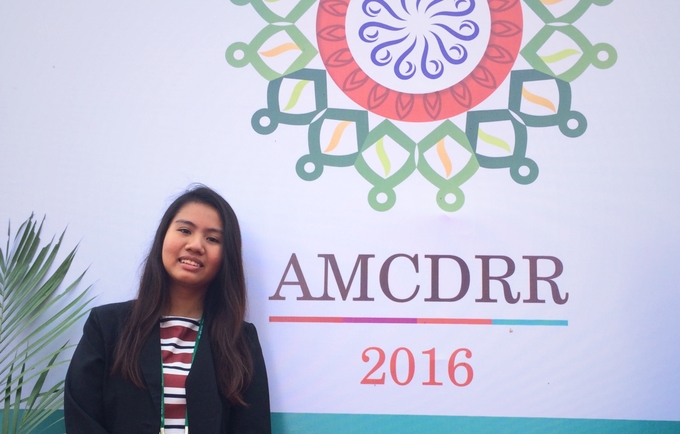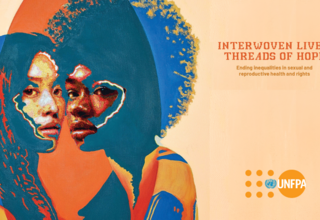Chloe Reynaldo (16) is a UNFPA-supported youth leader and peer educator on sexual and reproductive health and rights from the Philippines
Ever wondered what happens in special, high-level international conferences? Ever wondered about the topics discussed in the big convention halls with top-level security? Ever stopped to think and wonder, How will their decisions affect me, affect the people?
If you, (a) work for a humanitarian organization, congratulations, you have probably thought about these questions and already have the answers, learning firsthand by attending a conference yourself. But if you, (b) are a regular citizen, maybe a student or an employee, then you probably haven’t stopped to really think about these things. I bet you’re thinking of it now. Well, my friend, you’re in luck, because I’m here to take you behind the scenes of one of these special, high-level international conferences – the Asian Ministerial Conference on Disaster Risk Reduction.
As a Filipino, this conference is extremely important and relevant to me – the Philippines is the second most disaster-prone country in the world, right after Vanuatu. It is the most at risk country in Asia by far. My attendance there, as well as of the other Filipinos, is extremely essential, as it gives us the opportunity to use what we learn to improve Disaster Risk Reduction (DRR) strategies in our respective communities.
On November 2, Day 0 of the AMCDRR, we attended a Youth Pre-Conference, where all the youth delegates congregated to get a feel of the event and to have an opportunity to raise their voices and push for their respective advocacies. There was a presentation on priorities to be considered before, during, and after disasters – we, the youth delegates, were asked for our opinions and contributions to the existing draft. The version presented to us was well-rounded -- pushing for child and youth participation in disaster risk reduction and CCA, enhancing disaster preparedness, ensuring protection of children and youth in times of crises, and having access to basic services. However, I felt that there was something lacking; there was practically no mention of considering adolescent sexual and reproductive health. Perhaps the statements were crafted to be as general and encompassing as possible to cover all bases but that could also result to some important issues slipping through the crack.

Chloe highlights the need to focus on adolescent sexual and reproductive health in the session on children and youth
Now, apart from being the most at-risk country in Asia, the Philippines is also the only Asian country in which the rate of teenage pregnancies is still rising, in sharp contrast with the other countries where the rates are all decreasing. Perhaps it was because of that reason that it was never specifically mentioned, but as soon as we were given the opportunity of discussion, I brought it up. Just because the problem is not as serious in other countries does not mean that it is any less relevant. Adolescent sexual and reproductive health, and sexual and reproductive health needs in general tend to be overlooked when considering disaster response, and as a youth delegate and Peer Educator who has been given the opportunity to participate in this event, I knew it was my obligation to push for it and make more people aware of it. Right away, I saw how important it was for me to have done this – many youth delegates were unfamiliar with the concept. It seemed foreign to some of them, and as it was explained and discussed, I felt glad that I was able to bring the topic up to an audience that truly needed to know about it.
In the evening, we attended the Local Leaders Forum, another pre-conference event. We were joined by Kabita Balami, another UNFPA-supported Peer Educator from Nepal. She was to speak of her experiences on the field as a registered nurse. I was proud to see that among the panelists was another Filipina, Mayor Madelaine Alfelor Gazmen, Mayor of Iriga City in the Philippines. She was to speak of government involvement in DRR in their city, which is in an area that is especially prone to disasters. The event was a great opportunity to hear about the triumphs of local leaders in the field of DRR in different areas, such as the business sector, the government sector, and the youth sector.
Day 0 was packed, and Day 1, November 3, promised to be the same. The agenda was full of technical sessions, thematic sessions, and a featured event as well. Not to mention the huge exhibition center where all the humanitarian groups set up booths to get their messages and advocacies out. But I’m getting ahead of myself. The biggest highlight of the day was the opening ceremony, where the Prime Minister of India, His Excellency Narendra Modi, gave a speech to seek greater cohesion in the international response to disasters, and urged women to play a bigger role in disaster risk management. Security was tight – we weren’t allowed to bring bags inside! But that was a very small price to pay to stand in the audience of and listen to such a powerful and influential leader.
For the rest of the day, it was up to you which events you wanted to attend. You had a choice between two technical sessions in the morning – Understanding Disaster Risk, and Disaster Risk Governance. We attended the first, as it is more relevant to my work as a Peer Educator. There were several thematic sessions in the afternoon, focusing on different sectors in DRR and afterwards, we visited the exhibition booths. I got to visit the UNPFA booth – we even shot a few lines for a clip in a promotional video, along with Kabita. I’m so excited for how that will turn out.
All in all, my first two days here in the AMCDRR have been overwhelming. The level of participation and involvement by all the people attending is astounding. Aside from the aforementioned lack of focus on ASRH, the topics are extremely comprehensive, considering all types and natures of disasters and response thereafter. It’s an extraordinary privilege to be able to participate in an event such as this, and I’m eagerly anticipating the next two days, and being able to take you all inside of it.
Cheers!

At the UNFPA conference booth




